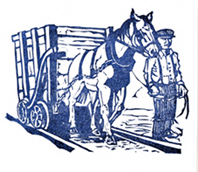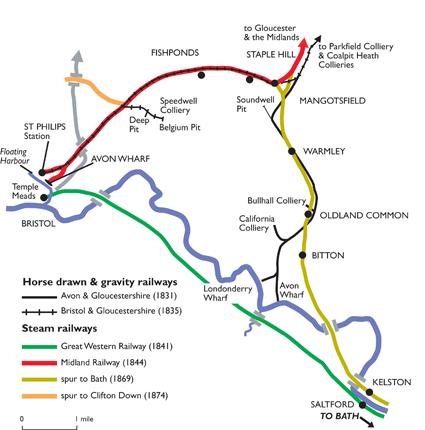The Midland Railway
The
Bristol & Bath Railway Path was constructed on the track bed of the former Midland Railway which closed for passenger traffic at the end of the 1960s. Between 1979 and 1986, the railway line was converted into the Railway Path.

Some of the former stations along the Path are still popular stopping points. They are also a source of historical interest - especially to rail enthusiasts.
The coming of the railway
The earliest section of Path, that connects Coxgrove Hill with Willsbridge, is part of the former Avon and Gloucestershire Railway which was built to carry coal from Kingswood's Coalpit Heath collieries near Yate down to the River Avon.
Begun in 1829, with sections opening between 1830 and 1834, the route of the Dramway as it is known today, was carefully constructed to make maximum use of the slope of the land down to the river. There are several cuttings and embankments along the route to give an even, gentle gradient. Coal was loaded into carts, or 'drams' and these were rolled slowly down the slope, led by horses and controlled by a brakeman or 'guide'. Horses pulled the empty carts back up the track to the coal mines.
Within a few years, the section from Mangotsfield to Bristol was reconstructed for the use of steam trains and became a part of the expanding national rail network. It was connected to Bath in 1869 when a new spur was opened from Mangotsfield. The route south to the quays on the River Avon remained horse-drawn until 1904.

The railway in the Bristol area
By the end of the 18th century there was already a strong demand for coal from existing Bristol industries - notably glass and soap making. The Bristol area had ample reserves of coal. Most of these lay to the east of the city. There had been small scale production in Kingswood for centuries. The new technology of the steam engine meant that not only did demand increase dramatically but there was also the power to move it to where it was wanted.
The great urban expansion happened in the late 19th century. Railway stations opened at Fishponds in 1866 and at Staple Hill in 1888. The tram system was extended to both areas in 1897. The new mobility meant that people no longer needed to live so close to where they worked. The train could also take people to the seaside or London, and bring them back, all in a day. The world of the commuter and the day tripper had arrived.

Mangotsfield
This area is one with historic significance for those with an interest in the old Midland Railway. The routes of both the original horsedrawn dramways converged near here and the Midland Railway passed through on its way to Bath when the new branchline was built in 1869. The new railway was constructed on a route parallel with the older dramway between Mangotsfield and Bitton. Long sections remain accessible as footpaths deserving exploration.
Kelston
This station, now demolished, was known as ‘Kelston for Saltford’. This was because the Midland Railway had to purchase land from local landowner Mr Inigo Jones of Kelston to create the track between Saltford and Bath. Mr Jones insisted that the station was positioned where it would benefit Kelston village even though this meant it would have no road access. Would-be passengers had to walk there. Not only did this create the need for a new, strong bridge to be built (1868) to take the track over the Avon at Kelston but yet more conditions were attached. One of these was that Mr Jones retained the right to stop any Midland train as long as he gave 24 hours notice.
Green Park Bath
Fine iron work is to be found decorating the nearby Destructor Bridge over the Avon. Such fine work is found in this industrial part of town because the bridge was moved from its original site near Green Park Station. Also close by is the Victoria Suspension Bridge. It is also known as ‘Dredge’s Bridge’ after its designer James Dredge who lost to Brunel in a competition to design the Clifton Suspension Bridge.
This Railway Path once carried trains further east towards Bath’s Green Park Station on the Midland Railway. The station was the Bath terminus for the premier service 'The Pines Express' and other trains between Bournemouth and the Midlands. Closing in the 1960s, part of Green Park Station has become a covered car park. Small shops, and a market area with cafes and eateries now shelter there too.
The line was judged to be uneconomic and closed in the late 1960s. But this was not the end of the story. In 1979, after hard work by Sustrans volunteers, the route was re-opened for cyclists and walkers – the first of a new kind of national network.
Find out more about the old railway from the
Midland Railway Society.
 Some of the former stations along the Path are still popular stopping points. They are also a source of historical interest - especially to rail enthusiasts.
Some of the former stations along the Path are still popular stopping points. They are also a source of historical interest - especially to rail enthusiasts.



